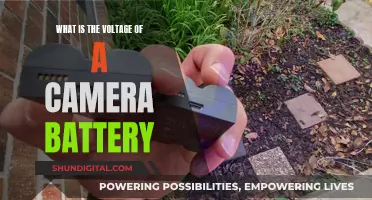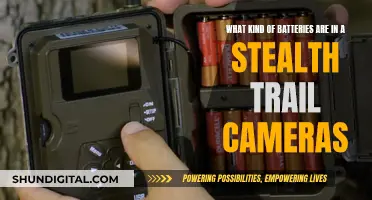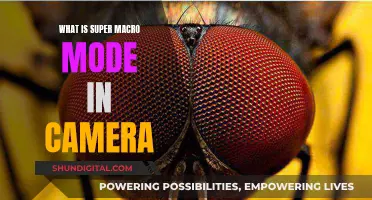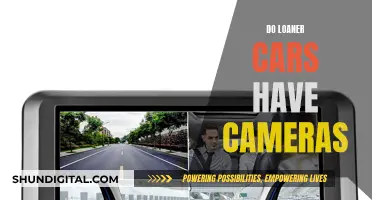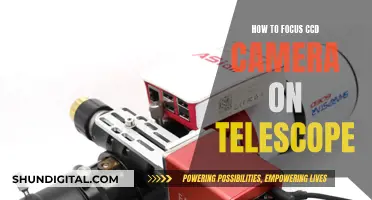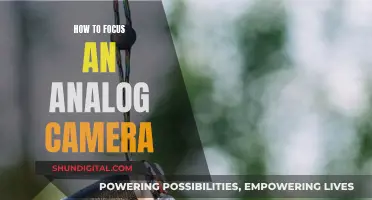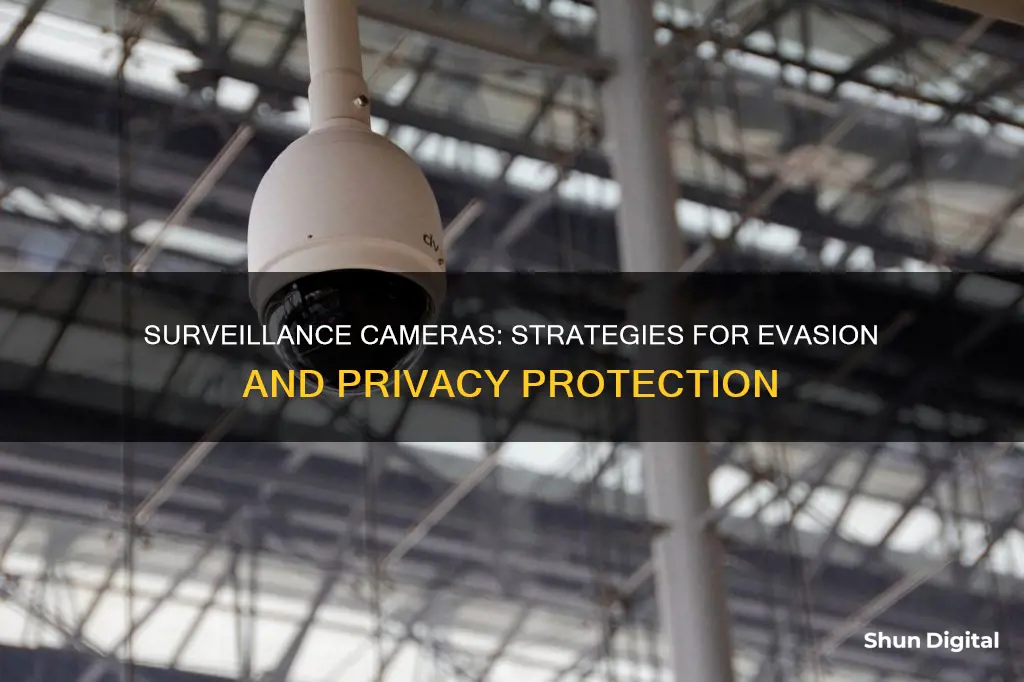
Surveillance cameras are everywhere, from shops to airports, and they are becoming increasingly difficult to avoid. However, there are several ways to beat them. One way is to use infrared LED lights attached to a cap, which are invisible to humans but appear as a bright light on surveillance cameras, especially those using night vision technology. Another method is to use lasers, which can damage the camera's imaging sensor chip. A less subtle but effective method is to shine a powerful LED or flashlight directly into the camera lens, creating a lens flare that obscures your face. For facial recognition technology, wearing a pair of dark glasses can help to cover one of the most useful areas of the face for recognition systems.
| Characteristics | Values |
|---|---|
| Wear anti-paparazzi clothing | Garments made with highly reflective materials to bounce the light from a camera flash back at the camera |
| Use lasers | Shine a laser into the camera to disable it. A higher-powered laser in the 100-milliwatt range will damage the imaging sensor chip permanently |
| Use infrared LED lights | Attach 840 nanometer wavelength IR LEDs to a cap to blind the camera |
| Use a paper mask | Wear a paper mask to trick facial recognition technology |
| Wear a hijab | Wear a hijab made with silver-plated fabrics that can reflect thermal radiation to disguise yourself from overhead drones |
| Use makeup | Use makeup to create asymmetry in your face to trick facial recognition algorithms |
| Wear glasses | Wear large opaque glasses or mirror glasses that blind the camera with reflected light |
| Use a powerful LED | Shine a powerful LED directly into the camera lens to obscure your identity |
What You'll Learn

Shine a powerful LED light into the camera lens
One way to beat surveillance cameras is to shine a powerful LED light directly into the camera lens. This method works best in the dark, so it is ideal for night-time or use in enclosed, low-light spaces. The brighter the light, the better. A small, powerful torch is ideal.
First, locate the camera and shine the light directly into the lens. This will create a lens flare, making it almost impossible to identify you. However, this method is not subtle and the sudden flash of light will likely alert security guards to your presence.
It is important to keep the light beam steady and not to shine it onto your face. This method requires precision and speed.
For a more long-term solution, you could attach infrared LEDs to your clothing. Superglue a string of bright lights to a hat or headband, or craft an LED "mask" to obscure your face. Ensure the lights are bright enough to blot out your face from view but not so bright that they are visible to the human eye or that they blind you.
Privacy Mode: Understanding Your Phylink Camera's Stealth Setting
You may want to see also

Wear anti-paparazzi clothing
Anti-paparazzi clothing is a real thing. These garments use highly reflective materials to bounce the light from a camera flash back at the camera. The way this works is that there is a pre-flash that helps the camera determine the right exposure settings. The reflected pre-flash makes the camera underexpose the picture, so everything is too dark.
There are a few brands that offer anti-paparazzi clothing. For example, Betabrand offers the Flashback Photobomber and Flashback Silverscreen, and ISHU offers anti-paparazzi scarves. The basic technique has been in use for quite a while by camera-shy celebrities worldwide. The trick is to use retro-reflective materials. These are textiles, plastics, or metals that will reflect light back to its source.
Imagine there was a way to trick the camera into thinking that the scene looks different than it actually does. If you were able to trick the camera into thinking the scene was much, much darker, it would tell the flash to increase its output. As a result, the image would be far too bright and probably ruined.
Reflective materials do the opposite; by reflecting a lot more light back at the camera than normal fabrics, the camera believes the scene is a lot brighter than it is and it reduces the flash output. In effect, the camera is exposing "correctly" for the reflective material, but incorrectly for everything else in the scene, probably ruining the photo.
Unfortunately, anti-paparazzi clothing is far from foolproof, and there are many ways to get around its effects. One of the problems is that most reflective materials are designed to reflect light back in a relatively narrow cone. So, if the photographer moves the source of the light (i.e., the flash) farther away from the lens, the effect diminishes. Unfortunately for unwilling subjects, a lot of photographers already move the flashes away from the lens, partly to get more natural-looking lighting and partly to avoid another type of reflection: the red-eye effect that can sometimes occur in photos.
Another way around the issue is to simply shoot without a flash. It's not always viable, but cameras these days are getting better and better results in near-perfect darkness. For example, see the short film Moonlight, which was shot just by the light of the moon. The imagery in the short may not be good enough for publication in your favorite tabloid, but it's better than no photos at all.
A quick-witted photographer can also avoid the problem by switching into fully manual mode on both the flash and the camera. If there are no electronics to fool, then there's no problem. In theory. In practice, if the photographer is able to expose correctly for the person behind the reflective clothing by increasing the flash output or using other camera tricks, the retro-reflective clothing will look extremely bright, and the images will probably not come out looking particularly good.
Finally, it would be possible to fix the photos in Photoshop later on. Shooting in Raw, as many photographers do, means that you get a lot of leniency in terms of editing photos after the fact, and even a woefully dark photo might be rescuable.
Anti-paparazzi clothing is interesting technology, but wearing it is no guarantee that your lovely face will stay out of the tabloids.
The Evolution of Color Photography: Capturing Life's Colors
You may want to see also

Use lasers to damage the camera sensor
Beating Surveillance Cameras with Lasers
Surveillance cameras are everywhere, and while they can make us feel safer, they also pose a threat to our privacy. If you're looking for ways to protect yourself from being watched, one method is to use lasers to damage the camera sensors. Here's a detailed guide on how to do it:
Understanding the Risk
Before attempting to damage a camera sensor with a laser, it's important to understand the risks involved. Lasers emit concentrated beams of light that can cause permanent damage to sensitive surfaces, such as the retina of the human eye. Camera sensors are generally more susceptible to damage than the human eye. Therefore, it is crucial to exercise caution when attempting this method.
Laser Types and Power
Not all lasers are created equal when it comes to their potential for causing damage. Ordinary lasers used for pointing during presentations or those found on keyrings have a relatively low power output of 1-5 milliwatts. While these lasers can affect a camera's auto-exposure system, they are not ideal for causing permanent damage.
For a higher chance of success, a more powerful laser is required. Lasers in the 100-milliwatt range are more likely to permanently damage the imaging sensor chip. These higher-powered lasers are typically used in industrial or scientific applications.
Direct Exposure
To effectively damage a camera sensor with a laser, direct exposure is necessary. The laser beam must be pointed directly at the camera lens. This allows the entire beam power to enter the camera lens and overload the pixels, causing irreversible damage. It is important to note that simply reflecting laser light off a surface is unlikely to cause the same level of harm.
Safety Precautions
When attempting to damage a camera sensor with a laser, it is crucial to prioritize safety. Always avoid pointing the laser directly into your eyes or the eyes of others. Additionally, if you are in an environment with lasers, such as a laser show or event, exercise caution. Do not point your laser at other people or their cameras, and follow any safety guidelines provided by the event organizers.
Damage Assessment
The severity of damage caused by a laser can vary. In some cases, there may be small areas of dead pixels that are unnoticeable unless they appear in an area of uniform color, such as a blue sky. More extreme cases may result in larger areas of dead pixels or "burn-in" of a laser image, rendering the camera useless for quality photography or videography.
Legal and Ethical Considerations
While this method can be effective in disabling surveillance cameras, it is important to consider the legal and ethical implications. Damaging property, including cameras, is generally illegal and can result in criminal charges. Additionally, surveillance cameras may be privately owned, and tampering with them could lead to civil liability. Therefore, it is essential to carefully consider the potential consequences before taking any action.
In conclusion, while using lasers to damage camera sensors can be a viable method for evading surveillance cameras, it comes with inherent risks and potential legal consequences. It is crucial to approach this method with caution and a thorough understanding of the potential outcomes.
Fujifilm Camera Not Charging: Troubleshooting Guide
You may want to see also

Wear a mask or disguise
Wearing a mask or disguise is one way to beat surveillance cameras. A paper mask, for example, can trick airport facial recognition technology. Researchers at the artificial intelligence company Kneron were able to fool systems across three continents by wearing paper masks.
Another way to disguise yourself from surveillance cameras is to wear "anti-paparazzi clothing". These garments use highly reflective materials to bounce the light from a camera flash back at the camera, causing the picture to be underexposed and too dark.
You can also use infrared LED lights attached to a cap. While this is invisible to humans, your face will turn into a glowing orb to surveillance cameras, especially those using night vision technology.
Makeup can also be used to trick facial recognition algorithms. You can create asymmetry by covering one eye with a feather or styled hair, use tonal inverse by applying makeup in strange directions and in unusual colours, or cover your nose bridge with face paint or creative hairstyling.
Finally, you can wear a photo-realistic, 3D-printed prosthetic mask of someone else's face, such as those created by URME Surveillance.
The Raw Camera Filter: Where Did It Go?
You may want to see also

Wear infrared LED lights
Wearing infrared LED lights is an effective way to beat surveillance cameras, especially those using night vision technology. The human eye can see a spectrum of radiation that maxes out at around 740 nm, but infrared waves are undetectable by the naked eye.
Infrared LED lights, such as those found in the Freedom Shield project, emit light at 940 nm, which is invisible to humans but detectable by cameras. By embedding these LEDs in clothing, the photo diodes in IR-sensitive cameras are overwhelmed, and the wearer's face is obscured.
A similar concept is the Camera Shy Hoodie, which features high-powered infrared LEDs sewn into the garment. These LEDs emit light at a wavelength that night vision security cameras can detect, rendering them useless. The hoodie, created by Mac Pierce, costs around $200 to make and uses mostly off-the-shelf parts.
While this method is effective, it is important to note that it may not provide complete anonymity. Those wearing such infrared LED lights may stand out, especially if they are the only ones using this method in a crowd. Additionally, security personnel could simply follow the person emitting the IR light. Nevertheless, it can be a useful way to avoid being identified by cameras, especially during marches or rallies.
Blender Camera Focus: What You Need to Know
You may want to see also
Frequently asked questions
Wear a pair of dark glasses. They cover the eyes, which is one of the most useful areas on a person's face for recognition systems.
Shine a powerful LED (light-emitting diode) or flashlight directly into the camera lens. This creates a lens flare, making it hard to identify you.
Point an infrared laser directly into the lens of the camera. This method works day or night but requires precision. If the laser-point slips away from the lens, the camera will catch your face.
Wear "anti-paparazzi clothing". These garments use highly reflective materials to bounce the light from a camera flash back at the camera, underexposing the picture.
Use infrared LED lights attached to a cap. This is invisible to humans but to surveillance cameras, especially those using night vision technology, your face turns into a huge glowing orb.


